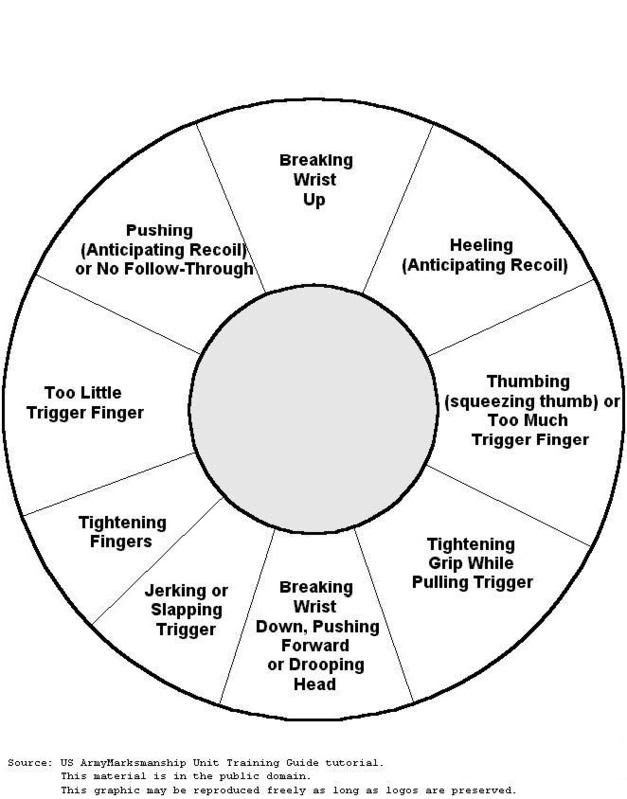
Big disappointment today. I stripped the gun and re-assembled using gun-tite (lock-tite for guns, removable thread-locker) to try and prevent the issues of the shroud and grip screws coming lose after around 100-150 rounds.
Everything seemed fine, but apparently I must have made a mistake tightening the grips too much. I got to the range and found out that the magazine release was extremely stiff, so the point where the return spring would not push the release back to the engaged position, and therefore it would not hold a magazine. I used the take-down tool to pry it loose from the open position so I could insert a magazine and also managed to bust a chip off the back of the wood grip.
So there was no shooting of the izzy today. Instead we used my buddy's Ruger MKII and his Springfield XDM .45. Shooting his Ruger is always fun; we put a new Hogue grip with finger grooves on it today and it feels a world better. Its already a great gun; there's been some kind of trigger work done. The gun has a longish first stage take up that is very light and then about a 2lbs crisp break on a very short second stage. Very easy to do rapid fire and really crank out the rounds.
We did a bit of tactical work shooting numbered targets. The non-shooter would tap the shoulder of the shooter who was in ready position with the muzzle at rest on the bench and call out 'even' or 'odd' on the 6-number target. The shooter would then engage a double-tap on each appropriate target and move to the next, continuing in a cycle until ammo was exhausted. We both used a Weaver-style stance (actually my buddy does a 'reverse weaver with his off-foot forward') and two-handed grip shooting at 3-5 yards. Its a lot of fun to shoot the MKII. However I don't like how 'tall' the sights are; they feel like they are a mile above the bore, making it hard to vertically place shots.
We then shot the Springfield. Its always a shock both a) the cost of .45 ammo and b) the recoil. I always tend to think the recoil will be worse than it actually is, and that probably helps me control what recoil there is and bring the gun back on target relatively quickly. Don't get me wrong, I don't have buff arms that can totally prevent muzzle rise like some guys you see on Youtube. But for a guy who hasn't shot a .45 but a few times, I thought I did pretty good. The trigger on the Springfield is, um, terrible from a target perspective, but its a carry-gun, and I understand why its setup the way it is from the factory. The initial stage feels very long and has a fairly light take-up, but its so long that it had me feeling that the trigger was not set a couple times because I thought I should have encountered the second stage! The second stage pull has some creep and feels pretty heavy, maybe 7lbs or so. I think the gun could benefit from a little bit of trigger work, a shorter first stage and a crisper and little lighter second stage, maybe 5lbs or so.
The Springfield grip is surprisingly good. Its nice and fat and the polymer texture really prevents any moving the gun in the hand under recoil. The sights are excellent, very clear 3-dot style and nice and low. We also shot the Springfield one-handed, to see how it would feel in a bullseye match. I did fairly well, although we were only shooting at 5-yards. The fundamentals of shooting the .22 certainly help with the .45 and that was reassuring; that my skills will translate to other calibers.
What plagued both myself and my buddy to a greater degree was a tendency to put too much finger on the trigger. I found myself at times having the second joint of my trigger finger on the trigger, which is a no-no. I think this was probably due to the heavy pull and I identified the problem in both of our techniques as the shots were pulling left.
This is a 'trigger rose', which is kind of like a wind-rose [I have to credit my mentor, George, for telling me about this graphic]. Its a map of the target and tries to identify what trigger behavior one might be doing that is causing shots to miss. According to this graphic, we were both probably anticipating recoil and that was over-whelming our tendency to use too much trigger-finger. We were probably slapping to some extent too. Trigger control certainly takes a lot of practice; its especially difficult on a heavy and slightly creepy trigger.

No comments:
Post a Comment